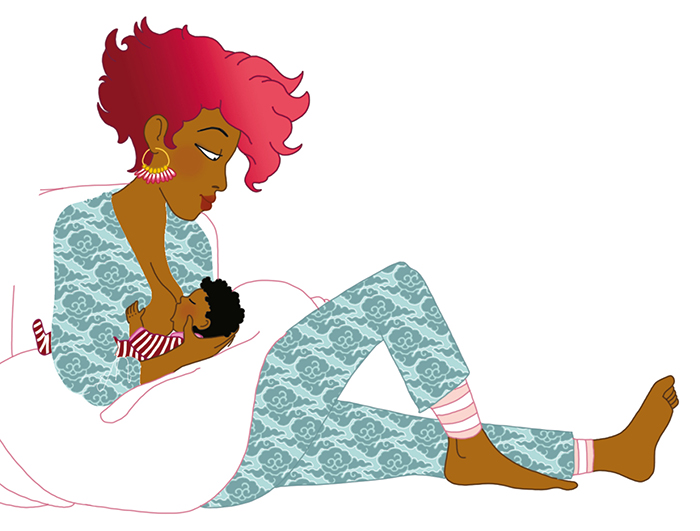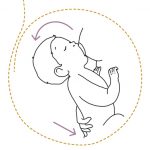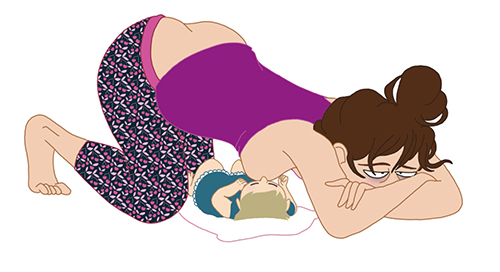Biological Nurturing
or instinctual breastfeeding. BN is, in fact, much more than just a position. It is the best way to starting really communicating with Baby.

What is it?
Often, we assume BN is just one of the many breastfeeding positions. Absolutely not! It’s a whole philosophy. suzanne Colson introduced a new breastfeeding paradigm in her thesis called Biological Nurturing, an approach with multiple components that make feeding more instinctive.

Here are the key points:
- Comfortably positioned in your chair/couch/bed (as if you were watching a film) open up your “body space” to make it easier for Baby to suckle as they please. Each mum chooses the position that suits her best.
- In a logical transition from skin-to-skin contact, Baby’s tummy is now directly touching yours.
- Placed on top of you, gravity ensures Baby stays there. Primitive reflexes enable Baby to latch on perfectly.
- Your eyes meet, boosting oxytocin and maternal instinct.
Primitive reflexes
You’ve probably already heard about certain instinctive gestures that a baby is endowed with from birth until 4-5 months of age. While they are often a source of wonder (when, for example, they start to walk automatically while the paediatrician holds them upright), they are especially useful for performing vital actions, such as feeding. Some of them are, therefore, essential for nursing.
As you will see in the following illustrations, simply pushing Baby’s cheek can set them off. Some gestures can cause confusion: if Baby « hits » your breast, « prefers » to suckle their hand rather than your nipple or « says no » with their head, you may believe that they are refusing to be breastfed. This actually means the exact opposite.
Let’s take a look at the practical side
BN is the ideal position for the first feeds. It is perfect for newborns (even premature) and can even alleviate several discomforts such as OALD (Over Active Let Down), hyper-lactation and cracked nipples.
When Baby is put directly on you, they can feed in any position around your nipple, which gives you 360 possibilities! Baby can lie on your torso, a major advantage if you had a caesarean and nothing can be placed on your stomach for the time being.

Trust yourself!
Follow your instincts. If you feel better placing Baby in one way more than another, just do it! YOU know what is best.
Positioning
Put Baby on your stomach, or across your chest, and surround them with your arm. It will help them get into the best position.
Full contact
They should be on top of you, with their feet pushing against something to help them find the right position.
Head held up high
Even if Baby can lift their head, they may need help saving their energy. If necessary, press your breast lightly with your finger to let air get into their nose.
Lots of cushions
Don’t skimp on them, nothing is more important than your comfort!
Wait until Baby is completely awake?
Forget about it!
 Il est idéal de pratiquer le BN en continu au cours des premiers jours après la naissance. Bébé est ainsi “à la bonne adresse”, près de votre mamelon où les tétées se font à volonté. Rien de tel pour booster votre lactation et débuter au mieux votre allaitement.
Il est idéal de pratiquer le BN en continu au cours des premiers jours après la naissance. Bébé est ainsi “à la bonne adresse”, près de votre mamelon où les tétées se font à volonté. Rien de tel pour booster votre lactation et débuter au mieux votre allaitement.
Car c’est là que l’approche BN prend tout son sens : Bébé peut téter quand il veut. Vous n’avez pas à attendre des signes d’éveil pour lui proposer le sein car ses réflexes restant actifs en plein sommeil paradoxal (état dans lequel il se trouve la plupart du temps), une tétée est tout à fait possible quand il dort.
Classic positions
When we imagine a mother nursing, the cradle position instantly comes to mind but there are lots of other positions that each boast multiple pros… and cons!

Little tips
Here are a few basics you should be familiar with when you start nursing. Don’t forget that at birth Baby has limited control over their neck muscles, except for raising their head when they are on their stomach. It is, therefore, necessary to help them out during the first few weeks.
Nice and straight
Hold Baby facing towards you, their head, neck and hips well aligned (if you don’t believe this, try drinking with your head turned towards your shoulder).
A welcoming setting
Think about your own comfort! Place cushions behind your back, on your thighs and under your arms, to avoid any aches and pains.
Let Baby’s head move freely
Never push Baby’s head during a feed. It won’t make them drink any more, quite the opposite, they will automatically break away from the breast.
Be careful of your back
Baby to breast not breast to Baby. Do not bend forwards, bring Baby towards your nipple (hence the need for cushions).
Hold your legs high!
Do not hesitate to use a footstool to lift up your legs. The horizontal position of your legs will stop Baby and the cushion from slipping.
Presenting your breast
If you have to hold your breast to help Baby latch on, do not cover any part of your nipple. Baby may only suckle the tip of it and end up hurting you.
The nose should be clear
If you have the feeling that Baby, buried in your breast, is having difficulty breathing, hold their buttocks tightly against you. This will make Baby change position slightly and lift up their nose. Never press down hard on your breast, as this may clog a milk duct.
Force them? Never!

If you practice responsive feeding, you should never force Baby to feed. However, even though it is almost impossible to force your breast into their mouth, maternity wards sometimes recommend keeping baby awake so that they can feed » efficiently » and quickly regain their birth weight. You may, for example, be advised to tickle their feet, rub ice cubes on them, rub their spine from top to bottom or wipe their face with a damp cloth. Sounds like torture, doesn’t it?
Remember Baby’s sleep is not yet mature and they cannot stay awake for long periods of time. As we saw in the Biological Nurturing chapter, Baby does not only suckle when they are awake (about 4h/24h: not easy to fit in all the feeds), Baby can also feed in REM sleep. Forget about these out-dated techniques and keep Baby near your breast.
They fall asleep while feeding? No problem! Let Baby rest and they will carry on nursing when they wake up. You’ll see, everything will be fine and Baby will soon be putting on weight.

The rugby hold
Easy to master, this position can also be used for premature babies. The rugby hold is useful if you have had a caesarean birth.
Positioning
Position Baby under your arm, their tummy against your side, on the side of the breast you’re feeding with. Your hand, placed at the top of their back, should also support their neck. Bring Baby close to you so they do not have to bend their neck forward. You have one hand free to hold your breast.
The cross cradle
Optimal control and good visibility, it is perfect for beginners, especially with premature babies.
Positioning
Having a free hand on the side of the suckled breast will help stabilise Baby if needed. Hold Baby with the arm opposite the breast used for the feed, with your palm underneath
Baby’s neck. Don’t forget: Baby shouldn’t turn their head to suckle.
A little help?
You can help Baby to latch on: put your free hand in a U-shape, squeeze your breast slightly in the direction of Baby’s mouth.
The cradle
This key position is practical and versatile.
Positioning
Baby is lying on their side facing you. Their head rests on your forearm, your nipple in front of their nose (or even their forehead).
Latching on
Baby will look upwards for your breast. When they lift their head with their mouth open, place Baby against your breast. Don’t forget: Baby shouldn’t turn their head to suckle.
Side-lying
Easy to use and relaxing since Baby does not need to be held. Be mindful about safety: you may fall asleep.
Positioning
Baby is facing your nipple. When they lift their head, pull them closer to you. Do not twist your whole body to position your breast in Baby’s mouth or you might put your back out.
Get some towels!
Remember to put one under Baby in case of any excess milk. And you can use one to protect your stomach from Baby kicking. Do not put a cushion behind Baby’s back, so that they can fall on their back freely.
Dangle-feeding
It may be unattractive (put your pride aside), but it is the ideal solution for draining an engorged breast or a clogged milk duct.
Positioning
Baby should be lying on their back suckling your breast, dangling above their nose. Direct their chin towards the painful area to drain it effectively.
Need some help?
Massage your breast during the feed to relieve any clogged ducts.
These excerpts are from My completely illustrated Breastfeeding Book.










